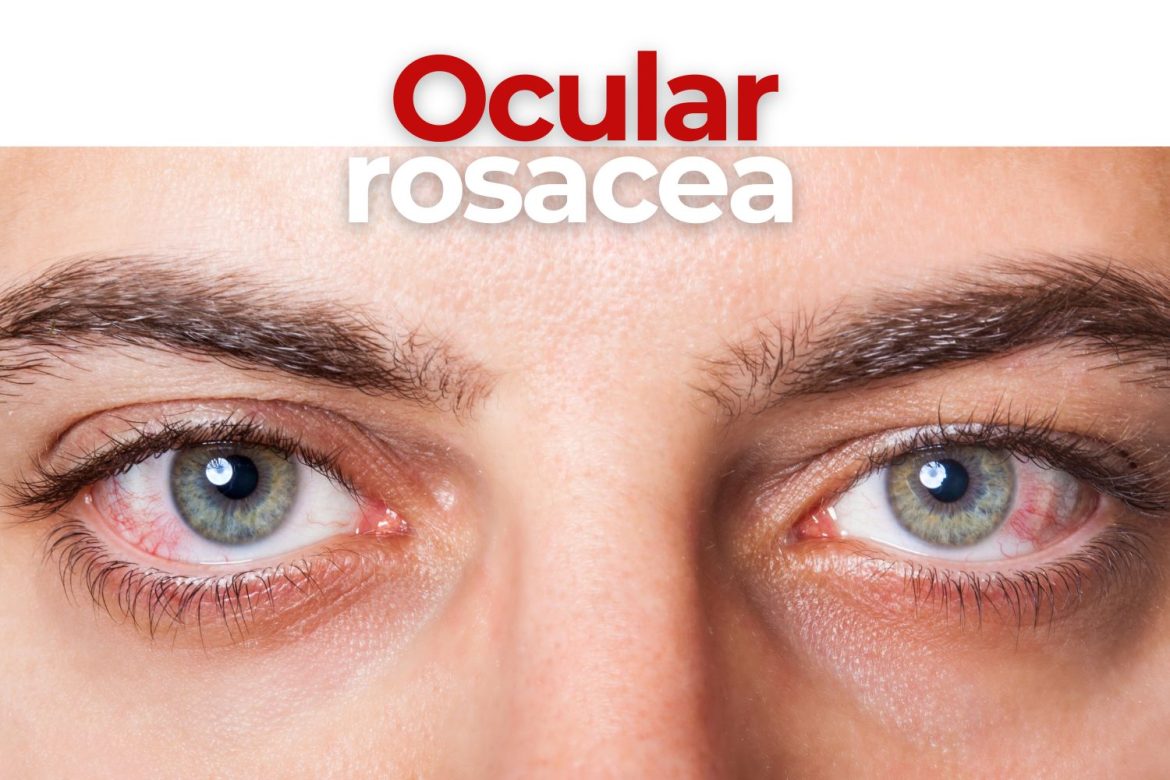![]()
What is rosacea? Rosacea is a chronic, inflammatory skin condition resulting in reddening skin and a rash on the nose and cheeks. Blood vessels and pus-filled spots are common signs. The skin can also become dry, swollen, flaky, and may burn or itch. The condition is non-contagious and can vary in severity.
Does rosacea correlate to a serious ocular condition?
It often does. In this post, we answer this and more common questions about ocular rosacea.
The exact cause of rosacea is unknown but it may be due to heightened skin sensitivity to environmental stressors like ultraviolet (UV) light and the microbes that live on the skin. The symptoms may be exacerbated by factors including the sun, stress, spicy foods, and caffeine. Patients are told to avoid these triggers.
There is no cure, but we have many solutions to treat rosacea as it often comes and goes.
Rosacea is more common among middle-aged, women, and those with fair skin. However, it is often under-diagnosed in children and in patients with a darker skin tone.
Besides skin redness, visible blood vessels may be present on the face and around the eyelids. The skin may appear thicker. In rare cases, rosacea can extend to other parts of the body, such as the sides of the face, ears, neck, scalp, and chest. Finally, ocular symptoms may be present.
It is estimated that 13 million Americans have rosacea, and more than half of them have ocular rosacea, according to WebMD.
What is ocular rosacea?
Ocular rosacea is inflammation of the eyes and eyelids that results in redness, burning and itching of the eyes. It often develops first in people who have skin rosacea, but a patient can have ocular rosacea without skin rosacea.
The most common ocular features are chronic blepharoconjunctivitis with inflammation of the eyelid margin, and meibomian gland dysfunction (MGD). Cornea complications include vascularization, ulceration, scarring, and in rare cases, perforation.
What are the symptoms of ocular rosacea?
Ocular rosacea is when the eyes become sore, red, itchy, watery, or dry. Your eyes may feel gritty or as if there is something in them, like an eyelash. Ocular rosacea may even cause light sensitivity or blurry vision. The eyelids may also swell and become itchy and red at the base of the eyelashes.
Styes are also common due to blocked glands around the eyelashes. As many as 85% of people with ocular rosacea may have blocked oil glands. Although, there are a lot of over-the-counter medications used to treat a stye, an oral antibiotic will be the quickest and most effective treatment.
Inflammation of the lids due to a condition called meibomian gland dysfunction (MGD) may cause worsening symptoms of dry eye disease.
MGD is used to describe a group of disorders caused by abnormalities in the meibomian glands. MGD can lead to changes in the tear film composition, ocular surface disease, ocular and eyelid discomfort, and evaporative dry eye.
Evaporative dry eye is the most common type of dry eye disorder. Symptoms of dry eye disease are similar to those of ocular rosacea and the most common include stinging, scratchy, burning eyes, light sensitivity, foreign body sensation, stringy mucus, and redness. Dry eye can also cause fluctuations in vision and difficulty driving at night.
How is rosacea treated?
Doctors agree that both rosacea and ocular rosacea require chronic treatment with a combination of both topical and systemic therapy. Early diagnosis and treatment are important to avoid potential complications.
Data from a recent study supports the use of 0.75% metronidazole, topical azelaic acid or topical ivermectin for inflammatory rosacea. These three topical medications can be combined into an ointment by a compounding pharmacy. The redness of the skin can be treated with brimonidine tartrate gel, an oral medication such as a beta blocker, or laser and light-based therapy.
In the past, many topical formulations caused irritation, but newer formulations use microencapsulation technology, or nanoparticles, to allow for the slow release of the drug to avaoid skin irritation.
Tetracyclines like doxycycline and minocycline have anti-bacterial and anti-inflammatory properties. Doxycycline taken by mouth can be used alone or with another medication for long-term treatment.
If you are taking a tetracycline, you must be careful to avoid the sun. Steroid eye drops and ointments can be used on a short-term basis to reduce redness and swelling.
The symptoms of ocular rosacea require a long-term lid hygiene routine to reduce eyelid inflammation and maintain the eyelids every day. Your doctor will recommend daily lid scrubs to keep the eyelids and eyelashes clean of debris.

Lid scrubs like Ocusoft with anti-inflammatory and anti-bacterial properties can be purchased to help prevent the reoccurrence of rosacea.
Warm compresses or a specially designed Bruder mask may be recommended to help keep the eyelid glands open and healthy oil to flow from the glands. Pulse light therapy treatments have demonstrated potential to improve the patient’s symptoms and improve the ocular signs of MGD.
Artificial tears with an oil component can be used to keep the eyes moist. One drop can be applied in each eye 4x or more per day.
Both rosacea and ocular rosacea can be difficult to manage and will likely require long-term treatment until the exact cause is uncovered. A patient should work together with their optometrist and dermatologist to formulate a treatment plan. Furthermore, it very important to manage the dry eye which results from the ocular rosacea to preserve the health of your eyes and maintain good vision.

